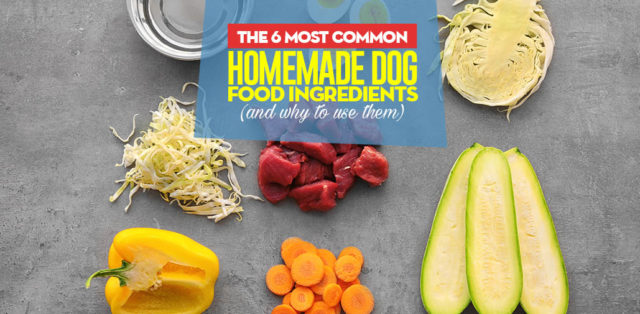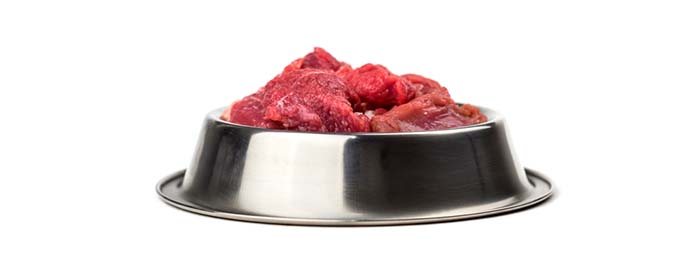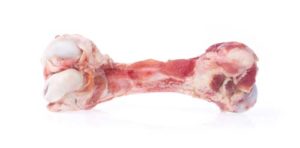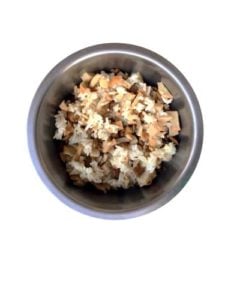
Table of Contents
Cooking for dogs from scratch is becoming the go-to approach for many pet owners.
While some recipes might end up costly, others will turn out cheaper than store-bought dog foods.
This is especially true when you can purchase the most common homemade dog food ingredients in bulk and use them for a variety of doggy meals.
When it’s well-prepared using the healthy ingredients that your pet enjoys, a homemade dog food meal can offer a Fido the natural taste and nutrition that no commercial dry or wet food can imitate.
Even though it's not without its dangers, a well-balanced meal is a much healthier alternative to many fillers- and grain-filled kibble brands.
The catch with homemade dog foods is that it's not always easy to achieve a very well-balanced meal.
Until you get a hang of it, homemade dog foods are more complicated than most owners realize.
There are a number of supplements that need to be added; your dog’s breed, size, age, gender, and physical condition need to be taken into account.
Homemade dog food ingredients are of the utmost importance — both finding the right ones, as well as storing them, putting them in the right proportions, etc.
If you’re new to homemade dog food cooking and you’re looking for some pointers, here are the 6 most common homemade dog food ingredients that will get you started on the right path.
You can also buy these in bulk, which will be cheaper, and when stored correctly, they can last a long time to make a large number of doggy meals.
ALSO READ: 50 Best Homemade Dog Food Recipes
6 Common Homemade Dog Food Ingredients
(and why you should use them)

Muscle Meat
Meat should be the first ingredient to come to mind when considering the best homemade dog food ingredients.
Muscle meat, in particular, must be the main (meaning, making up the largest percentage of the meal) ingredient of your dog’s meals.
Depending on which side of the debate you fall into, dogs may or may not be “real omnivores” like us or “preferential carnivores,” but they are predators and are much more meat-oriented than other omnivores.
According to studies and veterinarians, the best homemade dog food meal must include at least 25% – 50% meat (which will often be muscle meat unless you substitute it).
This will also depend on the exact type and fatness of the meat, the age, and the condition of the dog, as well as any other homemade dog food ingredients you're using (i.e., additional protein sources).
| Life Stage/Breed Type | Min. Protein |
| Puppy | 22-32% |
| Adult Dog | 15-30% |
| Performance Dog | 22-32% |
| Racing Dog | 28-34% |
| Lactating Dog | 25-35% |
Meat and muscle meat, in particular, serve as the best source of amino acids for dogs.
Canines require 22 amino acids, and while they can synthesize 12 amino acids out of those, they must consume the remaining ones from a diet higher in meat quantity and quality.
Essential amino acids dogs must get from homemade dog food ingredients you use in their meals include arginine, leucine, isoleucine, lysine, valine, histidine, methionine, phenylalanine, threonine, and tryptophan.
Organ Meat
Pet owners sometimes forget organ meat in their homemade dog food recipes, but it's the most nutritious (3, 4) of homemade dog food ingredients you can include in your pet's meal.
Some high-quality organ meat like kidneys, heart, and liver are also often cheaper than muscle meat.
It doesn’t need to be a part of every snack, but it would benefit your dog to include it as often as you can.
When you skip organ meats, you’ll have to stuff your dog’s homemade food with more artificial supplements to create a well-balanced meal; otherwise, your pooch will end up malnourished (5, 6, 7).
Protein aside, organ meats will also supply your pooch with the most essential vitamins and minerals, including iron, B vitamins, and folate.
Best organ meats for dogs may include:
- Liver: A “detox” organ, this is the nature's multivitamin.
- Tongue: Technically a muscle meat, it's full of healthy fats.
- Heart: A very lean source of protein.
- Kidneys: Another good source of protein and vitamins.
- Brain: It's rich in omega-3 fatty acids.
- Sweetbreads: Made of thymus gland and pancreas, they're highly nutritious.
- Tripe: Its chewy texture may not always be liked by dogs, but it's worth trying.
A good and well-balanced homemade dog food recipe will include both muscle and organ meat, and often anywhere between 5% and 20% organ meat, depending on the exact organs and whether you're using muscle meat or not (and how much).
Again, balance here is key as it's possible to include too much of organ meats.
For example, if you're using liver, don’t go over 10%, as liver meat is very rich. Beef hearts also shouldn’t exceed 5% as they are quite nutritious.
The exact breed, age, and condition of the dog are important in deciding what and how many organs you want to prioritize among your homemade dog food ingredients.
The other ingredients of the meal are important as well, as you don’t want to go over a certain fat percentage. Nevertheless, organ meat is a vital ingredient of your dog’s healthy diet.
Meaty Bones
 Calcium is often overlooked among homemade dog food ingredients to include in the pet's meal, yet it is as important to dogs as it is to us.
Calcium is often overlooked among homemade dog food ingredients to include in the pet's meal, yet it is as important to dogs as it is to us.
Calcium deficiencies are very common in dogs (8, 9), resulting from the lack of calcium, phosphorus, and vitamin D in the dog's diet.
A lot of recipes cut back on the bones because they are a choking hazard, and that’s a valid concern.
However, there are ways to cook and soften the bones so they don’t present such a choking risk.
There are different types and sizes of bones that are easier or harder to consume.
A proper homemade dog food diet includes between 12% and 15% bones (10, 11).
If you are worried about using bones, you’ll need to find a suitable alternative source of calcium.
A lot of people put crushed eggshells in their dogs’ food, which can be a good source of calcium, even though they are harder to measure.
Cottage cheese is a decent source of calcium as well. Lastly, you can always use calcium supplements.
Vegetables
Veggies (and sometimes fruits) are the second most sizable component of every dog’s healthy diet.
Depending on the exact recipe, your homemade dog food ingredients list should have some vegetables, anywhere from 30% to 50%.
Vegetables provide a ton of nutrition for the dog (12), including prebiotics, chlorophyll, flavonoids, carotenoids, fibers, and more.
The carbohydrates from vegetables are often the lower end and will often come from fiber.
Fiber is vital as it promotes healthy digestion and nutrient absorption in dogs (13, 14).
Vegetables also provide a ton of necessary vitamins and minerals, plus they offset some of the negatives of the fat in your dog’s diet.
Carrots, broccoli, sweet potatoes, peas, and others are the most common homemade dog food ingredients from the list of vegetables for your dog’s meal.
Grains
 Grains are one of the more controversial ingredients in both commercial and homemade dog food diets.
Grains are one of the more controversial ingredients in both commercial and homemade dog food diets.
They are definitely used in far greater quantities in commercial dog food than they should be, and dogs do not require such large quantities of grains in their diet.
Too much and too unsuitable grain content in your dog’s commercial kibble can lead to a lot of problems (15), such as allergies, arthritis, and inflammatory bowel disease (IBD).
That being said, when used in an adequate proportion of 5% – 10%, when they are well-picked and well-cooked, grains like brown rice and oatmeal should present no danger for your dog, and they should even help with his or her digestive tract.
Grains remain one of the most common homemade dog food ingredients to use because grain-free diets have also been found to be less healthy than high-grain diets (16). Balance is key.
Fat Sources
Fats may be looked down upon by some pet owners whom the industry has misled about the “potential dangers of fat,” but healthy fats are actually essential to dogs (just as they are for humans).
Fat is a source of energy for dogs, particularly for working and athletic dogs (17), who burn a lot of calories during the day; it's a better source of energy than carbohydrates.
Fats are also essential for maintaining a healthy and shiny coat.
It needs to be used in moderation and in sync with the rest of the homemade dog food ingredients you include in the meat, as well as considering the serving size of homemade dog food meals for your pooch.
Veterinarians usually recommend the below amounts of healthy fats in the dog's diet:
| Life Stage/Breed Type | Min. Fat |
| Puppy | 10-25% |
| Adult Dog | 10-20% |
| Performance Dog | 15-40% |
| Racing Dog | > 50% |
| Lactating Dog | > 20% |
READ NEXT: 10 Homemade Dog Food Delivery Services from around the Globe











